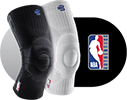Whether you’re new to skiing or snowboarding or are shifting from one to another, our guide walks you through all the gear you’d need.
“Skier’s Thumb” is an acute injury to the ulnar collateral ligament (UCL) at the base of the thumb. When the UCL is stretched or torn it can cause pain and limit the thumb’s natural grasping movements. Depending on the severity of the injury, it can take weeks or even months to recover. When the injury is caused by chronic use, it’s sometimes called Gamekeeper’s Thumb.

“Best Brace for Skier’s Thumb”
RhizoLoc Thumb Brace
Skiers know the feeling: all it takes is a fall with your ski pole in hand and you can be stuck with an unpleasant souvenir of the mountains for a long time. For the overstretched capsular ligament complex to recover quickly, the joint requires stability. This is because we put more strain on our thumbs than we realize. Bauerfeind’s RhizoLoc provides immobilizing support that can be gradually loosened to allow more mobility as you progress in recovery from Skier’s Thumb.
- Protects the thumb after injury, surgery and in cases of osteoarthritis
- Thumb immobilizer can be loosened in a controlled manner
- Easy to put on and take off with one hand
Causes of Skier’s Thumb:
The injury occurs when the ligaments of the base of the thumb are suddenly stretched or torn. As the name implies, many cases of “skier’s thumb” occur when a skier suffers a fall without letting go of the ski pole. Other situations where the thumb is forcefully bent backwards or to the side can also cause skier’s thumb, like in a car accident or even more rarely during a fall on an outstretched hand.
Symptoms of Skier’s Thumb:
- Pain and swelling at the base of the thumb, between thumb and index finger
- Weakness or difficulty in grasping (ex. holding a pen or turning a doorknob)
- Thumb pain that worsens with movement
- Pain in the wrist (which may be referred pain from your thumb)
- Redness or bruising
Skier’s Thumb Treatment Options:
Treatment options for Skier’s Thumb will depend on the severity of your condition. While a complete tear of the UCL will likely require surgery, more minor sprains can usually benefit from a combination of conservative treatments:
- Home Remedies - RICE therapy (rest, ice, compression, elevation) and over the counter pain relievers like Tylenol and ibuprofen can be a first aid resource for reducing minor skier’s thumb symptoms like pain and swelling.
- RhizoLoc Thumb Brace - Your doctor may recommend 4-6 weeks wearing an immobilizing thumb splint. Bauerfeind’s RhizoLoc can be adjusted to loosen restrictions over time as recovery progresses.
- Physical Therapy - A physical therapist will guide you through rehab to regain strength and mobility as you heal from your Skier’s Thumb injury.
- UCL Repair Surgery - Performed by an orthopedic surgeon or hand specialist, a UCL repair will reattach the ligament and is usually followed up by 4-6 weeks of wearing an immobilizing thumb splint like the RhizoLoc Thumb Brace.
Other thumb injuries:
Skier’s Thumb is closely related to Gamekeeper’s Thumb and often confused with other thumb injuries like DeQuarvain’s Tenosynovitis (also known as “texting thumb”, “mommy thumb” and other nicknames).
FAQs:
“Skier’s Thumb” is the result of stretched or torn ligaments at the base of the thumb. As the name implies, it often occurs when a skier suffers a fall without letting go of the ski pole. Other situations where the thumb is forcefully bent backwards or to the side can also cause Skier’s Thumb, like in a car accident, or even more rarely during a fall on an outstretched hand.
Skier’s Thumb is an injury known to linger for weeks or even months, even with proper treatment. Once you’ve immobilized the thumb with a thumb splint like the RhizoLoc, it’s important to have it evaluated by a healthcare professional to ensure you’re on the right treatment plan for a quick and full recovery.
Treatment options for Skier’s Thumb will depend on the severity of the injury. For a mild sprain, you may be instructed to keep the thumb immobilized to allow the stretched ligament to heal. With a thumb splint like the RhizoLoc thumb brace, you can gradually loosen the restriction and allow more mobility to the joint as you progress in your recovery.
If your Skier’s Thumb is more severe it may require surgery and/or physical therapy along with bracing. It’s important to see your healthcare provider to ensure you’re on the proper treatment plan.
Skier’s Thumb usually takes between 4-6 weeks to heal, depending on its severity and proper treatment. The most important first step is to immobilize the thumb with a splint like the RhizoLoc thumb brace until your healthcare provider can give you a full examination and provide you with a complete treatment plan.
Understanding how Skier’s Thumb happens can help you avoid it yourself. Falling down while holding a ski pole is the number one cause of Skier’s Thumb, so skiers should remember to discard their ski pole if they fall. Ski poles with finger grooves rather than wrist straps or closed grips are best, as they can be more easily let go in case of a fall.



